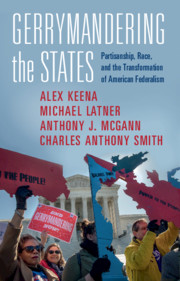Book contents
- Gerrymandering the States
- Gerrymandering the States
- Copyright page
- Contents
- Figures
- Tables
- Acknowledgments
- 1 Redistricting Wars in the US States
- 2 What Happened in 2011? The Other “Great Gerrymander”
- 3 When Politicians Draw the Maps
- 4 How Political Geography Affects Bias
- 5 Racial Geography, the Voting Rights Act, and Bias
- 6 The Policy and Social Consequences of State Legislative Gerrymandering
- 7 The Democratic Harms of Gerrymandering
- 8 When the Courts Redistrict
- 9 How to Design Effective Anti-gerrymandering Reforms
- Conclusion
- References
- Index
5 - Racial Geography, the Voting Rights Act, and Bias
Published online by Cambridge University Press: 02 July 2021
- Gerrymandering the States
- Gerrymandering the States
- Copyright page
- Contents
- Figures
- Tables
- Acknowledgments
- 1 Redistricting Wars in the US States
- 2 What Happened in 2011? The Other “Great Gerrymander”
- 3 When Politicians Draw the Maps
- 4 How Political Geography Affects Bias
- 5 Racial Geography, the Voting Rights Act, and Bias
- 6 The Policy and Social Consequences of State Legislative Gerrymandering
- 7 The Democratic Harms of Gerrymandering
- 8 When the Courts Redistrict
- 9 How to Design Effective Anti-gerrymandering Reforms
- Conclusion
- References
- Index
Summary
We investigate the impact of Voting Rights Act reforms that have required states to draw “majority-minority” districts and to abandon the use of multimember state legislative districts. Have these changes led to more bias in districting, as is often claimed? Our findings show that Republican bias is not an unavoidable outcome of minority districting. When Republicans are in charge, we often find more bias in states with large and geographically segregated Black and Latinx populations. In this regard, Republican gerrymanderers appear to use majority-minority districting as a tool for creating partisan advantage. But we do not see the same outcomes when Democrats, both parties, or independent actors are in charge. We also find that among the handful of states that still use multimember districts to elect state legislators, the average district magnitude in a state legislature imposes a ceiling on the level of bias achievable. However, when partisans are not in charge, multimember districts do not appear to limit partisan bias. Once again, the key variable in predicting the occurrence of bias in districting is whether or not one party controlled redistricting.
Keywords
- Type
- Chapter
- Information
- Gerrymandering the StatesPartisanship, Race, and the Transformation of American Federalism, pp. 96 - 116Publisher: Cambridge University PressPrint publication year: 2021



